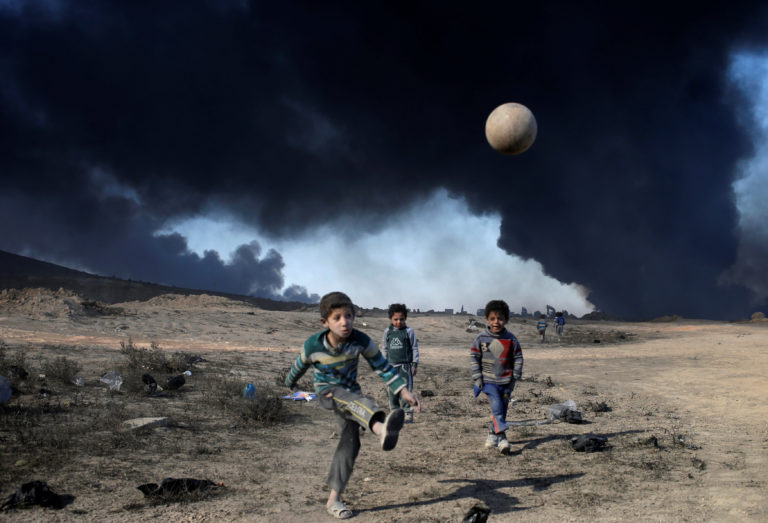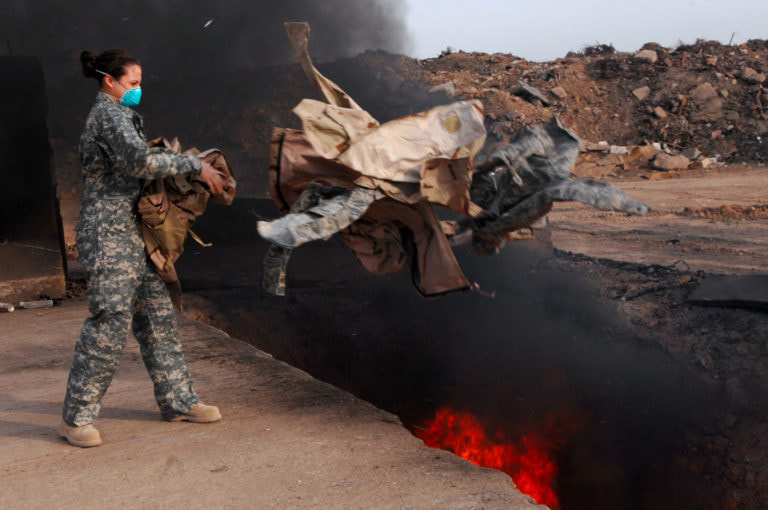The accompanying case reports are brief and often incorporate prognoses like “incompatible with life” or “stillborn.” The reproductive history of the mother is sometimes included as well. While most of these children do not survive, some live for weeks, months or years, often in pain and with grave disabilities.
Samira Alaani, a pediatrician at the Falluja General Hospital, is among several doctors who started noticing a wide range of uncommon birth defects among the infants delivered after the start of the US occupation in 2003.
Not only were birth defects high in number, they were also new and unusual in kind. Alaani and her colleagues were among the first to sound international alarm by publishing reports documenting the high rate of birth defects observed in hospitals in Falluja and Basra. In 2013, Alaani stated in an interview with the BBC:
The Falluja Hospital’s birth defects Facebook page, initiated in 2011, posts these cases for a reason. As an archive, the bodies of children become evidence of a much broader story about the toxic legacy of war in Iraq. The country has suffered consecutive decades of war, bombing campaigns, burn pits, sanctions and other military interventions that not only shatter the public infrastructures necessary for health and well being, but also trigger cascades of environmental degradation.
War Ecologies
Environments that bear the scars of political violence, and whose preservation in some form serves as testimony to that violation, are called evidentiary ecologies.[3] Birth defects in Iraq are part of an evidentiary ecology of war brought to political and moral attention through the practices of archiving and documenting.
When Iraqi scholars and doctors catalogue incidences of birth defects and note that their rates exceed that of Hiroshima, or when epidemiologists conduct studies to mark where, when and how a population experiences birth defects, they highlight the connections between militarism and public health, global inequalities and environmental racism.[4] Majid, a physician who treats children with heart defects in Falluja, said in an interview, “When people see birth defects, there is no avoiding the issue. Birth defects say, ‘Something is wrong here,’ in a way that other medical problems do not.”[5]
Applied to the Middle East, the term ecologies of war often refers to environments transformed by decades of intensive militarism. In Lebanon Iraq, Afghanistan, Palestine and Syria, such ecologies are not always accidental side effects of military operations but are instead central components of military strategy.[6] For example, Iraqi president Saddam Hussein drained the marshes of southern Iraq as a direct counterinsurgency tactic to suppress the Marsh Arabs, whom he accused of disloyalty during the Iran-Iraq war (1980 –1988).[7] When the Iraqi marshes were reflooded in the name of ecological restoration after 2003, it was part of a broader restructuring of Iraq’s environment and economy, alongside other mechanisms of spatial control like the use of T-walls (portable concrete walls).[8]
Beyond deliberate spatial and social transformations, chemical pollution also shapes Iraq’s war ecologies. While living and working with internally displaced farming families from Anbar province in 2014 and 2015 I witnessed plant crops and livestock with malformed parts or tumorous growth. Many farmers kept photographs and told stories of destroyed irrigation systems, contaminated water and hypersalinized soil. Infertility, cancers and birth defects prevented them from having and raising healthy children. They described birth defects as just one consequence of the environmental damage they witnessed in all aspects of their lives.
Many Iraqis I spoke to described these enduring environmental maladies as intentional. Ahmed, the father of a child who died within a few hours of her birth from multiple birth defects, said, “The Americans wanted this. If they didn’t, they would have cleaned up from their wars. They starved us during the sanctions; now they are poisoning us.”[9] When Ahmed speaks of being poisoned, he refers to both the enduring life of toxic war materials embedded and abandoned in Iraq’s landscape and the destruction of the human resources needed to cope with public health crises.
US military intervention heavily damaged Iraqi infrastructure and ecologies that sustain human survival, especially during the initial invasion in 2003 but also later during the occupation (2004–2011). Adhering to a “shock and awe” strategy, the United States launched 800 cruise missiles within the first 48 hours of the invasion in March 2003 —more than double the number of missiles launched in the entire Gulf War.[10] Between 2002 and 2005 alone, the US armed forces expended 6 billion bullets—roughly 200,000-300,000 bullets per individual killed in Iraq.[11]
This number of shells, full of lead and mercury, does not include larger ordinances or other metal remnants from after 2005, or from previous wars: the Iran-Iraq war (1980–1988), the First Gulf War (1990–1991), the sanctions era (1991-2003) and the 2003 occupation’s instigation of a further decade of militia warfare. The most recent military intervention in Iraq was accompanied by unprecedented waste abandonment and waste burning: discarded vehicles, excess weapons, discarded clothing and much more were all left in Iraq’s land, water or air.
Given the onslaught of military toxic dumping in Iraq, from spent bombs and bullets to base-making, burn pits and junkyards, it is no surprise that widespread cancers and congenital anomalies, along with other major health issues in the civilian population, abound. The medical resources to cope with cancers and birth defects, however, are also impacted by the enduring effects of total war—the targeting of an entire population and their environment, rather than military installations alone. Hospitals in Falluja, for example, have been targeted repeatedly by multiple entities, including by the United States in 2008 and by the Iraqi government in 2014 and 2015.[12] Additionally, medical doctors remain in short supply, since many were assassinated by militias or displaced by militia threats to their families: By 2008, only 9,000 doctors were living in Iraq.[13]
Toxic Legacies
Despite specific epidemiological attempts to pin down the causes of birth defects in Iraq, there is not just one. Studies based in Falluja, which sustained extensive damage during US assaults between 2004 and 2008, show a high rate of congenital malformations (15 percent of all births), higher than expected rates of cancer and infant death and an anomalous ratio of males to females in children under age five. In 2010, Chris Busby, a British scientist studying the health effects of radiation, released a study that showed a 12-fold increase in childhood cancer in Falluja since the 2004 attacks.[14]
Another study found that newborns with birth defects carried a level of lead three times higher, and a level of mercury six times higher, than average children in Iran, who have traces of lead and mercury just slightly higher than in European countries.[15] In the Iraqi village of Hawija, levels of magnesium and titanium in children with birth defects were nearly double the average of their counterparts in Iran, while alarmingly high levels of cadmium and arsenic were found in samples taken from children with symptoms resembling cerebral palsy. These metals can account for a large number of neurological problems and underdevelopment in fetuses by causing folate depletion and subsequent underdevelopment of vital tissues.[16]
Depleted uranium is one of the most widely discussed contaminants in relation to birth defects. The World Health Organization released a report in 2003 entitled “Potential Impact of Conflict on Health in Iraq,” which suggested that depleted uranium might be related to reports of increased cancers, birth defects, reproductive health problems and renal diseases in the Iraqi population since 2003.
International activists accused the US Department of Defense of negligence for using a weapon in Iraq that distributes toxic waste to where civilians live, grow food and draw water. Studies of American veterans hit by friendly fire with depleted uranium shrapnel have also demonstrated links between uranium and perturbations in reproductive hormones, including infertility.[17]
Additionally, US bases in Iraq used burn pits to incinerate everything from computers to tires in large open-air pits that burned day and night for years. They released high levels of dioxin and innumerable other toxins that are known to cause health problems, from birth defects to neurological issues.
Ecologies of war are not all the same, nor are their implications. Specific environmental conditions shape exposure to war toxins. For example, dust storms in Iraq are common, as is extreme high heat, which increases the distribution of toxins. A history of sanctions and long-term war shapes the way Iraq’s medical community is equipped to document and respond to a public health crisis.[20] Iraq’s environment has been transformed by many decades of Western military intervention, from British colonialism to US bombing; from sanctions to counterinsurgency and militia warfare.
The Body Count
Over time, bodily harm becomes more difficult to ascribe directly to war, even as the actual harm may increase. Birth defects are strong, visible indicators of what so many Iraqi people face amid broader toxic conditions of daily survival. Almost everyone I met in Iraq identified the high prevalence of birth defects as a post-2003 phenomenon directly related to war. Many women described having healthy children before 2003, and either many miscarriages or children with severe birth defects later. It was not uncommon for a family to line up their children by age so I could witness the visible line of before-and-after the US invasion.
In my interview with Majid, I learned that many doctors are now advising women with a birth history of multiple birth defects to simply stop conceiving children. In a country where terminating pregnancies remains illegal, and where resources for research, testing and treatment are limited, women can face a lifetime of perpetual physical and emotional turmoil as they repeatedly carry and bear children who cannot survive. Some of the women I lived and worked with from Anbar province felt strongly that precluding the possibility of reproduction was evidence of genocidal intentions by the United States. Dina, who experienced several miscarriages, expressed the desire to have her miscarried children counted among those who died from war. “But of course,” she noted, sarcastically mimicking an American man’s voice, “The US does not keep a body count!”[21]
As Omar Dewachi writes, the toxic legacies of militarism call us to “expand our analytical perspectives to rethink what an archive of war history would include.”[22] Certainly, in Iraq, an archive of war includes the bodies of children whose forms and futures are irretrievably shaped by Iraq’s war ecology.
Source (Click Here)



 RSS Feed
RSS Feed